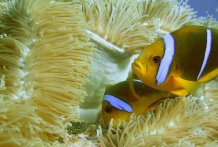
Image courtesy of Dr Suzanne Mills.
Clownfish males become fierce females if their ‘wife’ is eaten
Male clownfish, immortalised in the film Finding Nemo, change sex completely if their female mate is eaten or dies, research by marine biologists shows.
Research presented at the University of Exeter shows that male clownfish – which are a distinctive orange colour with blue-white stripes bordered by black - become female to protect their anemone territory and their anemone fish group.
Female clownfish are larger and more aggressive than males and even attack sharks.
Clownfish, or anemonefish, live in tropical climates on anemones where they stay their entire lives. Male fish tend to look after the eggs and fan them while females act as security guards, scanning the surroundings for predators, issuing warning calls and even launching attacks.
In the film Finding Nemo, a young clownfish’s mother is eaten by a barracuda but his father, Marlin survives. Nemo, the only surviving baby, is then lost and pursued by sharks before eventually finding his way back to his father.
In reality, if a mother clownfish is eaten, its mate changes sex completely and becomes a female, even laying eggs. To ensure the survival of the clownfish group, Marlin would have become Marlene, and mating with a younger male mate from the adolescent population already living on the anemone.
Dr Suzanne Mills, an evolutionary biologist from École Pratique des Hautes Études at CRIOBE in France and Dr Ricardo Beldade, a marine biologist with Centre National de la Recherche Scientifique at CRIOBE, have researched the behavioural, physiological and hormonal changes in anemonefish, or clownfish, over several years in Moorea, French Polynesia.
They presented their findings at the 50th Anniversary Symposium of the Fisheries Society of the British Isles at the University of Exeter.
“Anemone fish don’t move from their anemone for the whole of their life. The largest individual is the female, and if that female gets predated upon or dies, the male - Nemo’s dad - then changes sex and becomes a reproductive female. So when Nemo finally gets back to his anemone at the end of the film, he’s actually meeting his Mum,” Dr Mills told marine biologists at Exeter University.
She added: “The female is aggressive to predators and protects the anemone. If she dies or is eaten then the male changes sex over a few weeks. There need to be lots of hormonal changes to become fully female. When the male has changed sex, the largest sub-adult male becomes her new mate with whom she lays eggs. We’re investigating how these hormonal, behavioural and physiological characteristics of anemonefish are affected by climate change and other human-induced changes such as boat engine noise ”
Dr Beldade who studies the behaviour and genetics of clownfish in French Polynesia said: "Because of the sex change the same individual can have an opportunity to breed as a male and a female. The couple defends the anemone together in their own way and they both need each other to survive and reproduce."
Date: 15 July 2017
